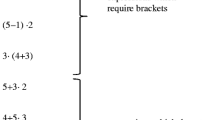Abstract
Complex operant procedures are not easy to describe unambiguously and several abstract notation systems have been developed for such description. Although they have not been generally adopted, such systems could be especially valuable to the teacher and student of behavior analysis, functioning like other figures and graphs as visual aids to ordinary verbal description. One of these systems, state notation, is described in some detail, and examples are provided of its use in teaching about behavior analysis.
Similar content being viewed by others
References
Davenport, D. G., & Olson, R. D. (1968). A reinterpretation of extinction in discriminative avoidance. Psychonomic Science, 13, 5–6.
Estes, W. K., & Skinner, B. F. (1941). Some quantitative properties of anxiety. Journal of Experimental Psychology, 29, 390–400.
Ferster, C. B., & Skinner, B. F. (1957). Schedules of reinforcement. New York: Appleton-Century-Crofts.
Kushner, H. K., Knapp, J. Z., & Snapper, A. G. (1967). A generalized behavioral controller. In IEEE proceedings of the 20th annual conference of Engineering in Medicine and Biology, Boston, Mass. (Vol. 9, 35.2). Washington, DC: MacGregor and Werner.
Mawhinney, T. C. (1991, May). An experimental analysis of leadership. Paper presented at the meeting of the Association for Behavior Analysis, Philadelphia.
Mechner, F. (1959). A notation system for description of behavioral processes. Journal of the Experimental Analysis of Behavior, 2, 133–150.
Michael, J. (1963). Laboratory studies in operant behavior. New York: McGraw-Hill.
Michael, J. (1988). State notation for behavioral contingencies. (Available from Jack Michael, Psychology Department, Western Michigan University, Kalamazoo, MI 49008.)
Michael, J. (1993). Establishing operations. The Behavior Analyst, 16, 191–206.
Millenson, J. R. (1967). Principles of behavior analysis. New York: MacMillan.
Pierce, W. D., & Epling, W. F. (1995). Behavior analysis and learning. Englewood Cliffs, NJ: Prentice-Hall.
Shafer, E. (1988). A program of instruction to teach state notation. (Available from Jack Michael, Psychology Department, Western Michigan University, Kalamazoo, MI 49008.)
Skinner, B. F. (1948). “Superstition” in the pigeon. Journal of Experimental Psychology, 38, 168–172.
Skinner, B. F. (1957). Verbal behavior. New York: Appleton-Century-Crofts.
Skinner, B. F. (1958). Diagramming schedules of reinforcement. Journal of the Experimental Analysis of Behavior, 1, 67–68.
Snapper, A. G., & Kadden, R. M. (1971). Time-sharing in a small computer based on use of a behavioral notation system. In B. Weiss (Ed.), Digital computers in the behavior laboratory (pp. 41–97). New York: Appleton-Century-Crofts.
Snapper, A. G., Kadden, R. M., & Inglis, G. B. (1982). State notation of behavioral procedures. Behavior Research Methods and Instrumentation, 14, 329–342.
Snapper, A. G., Kadden, R. M., Knapp, J. Z., & Kushner, H. D. (1967, June). A notation system and computer program for behavioral experiments. Paper presented at the meeting of the Digital Equipment Computer Users Society, New York.
Snapper, A. G., Knapp, J. Z., & Kushner, H. D. (1967, August). On line programming: I. Paper presented at the meeting of the American Psychological Association, Washington, DC.
Snapper, A. G., Knapp, J. Z., & Kushner, H. D. (1970). Mathematical descriptions of schedules of reinforcement. In W. N. Schoenfeld (Ed.), The theory of reinforcement schedules (pp. 247–275). New York: Appleton-Century-Crofts.
Snapper, A. G., Ramsey, D. A., & Schoenfeld, W. N. (1969). Disruption of a temporal discrimination under response-independent shock. Journal of the Experimental Analysis of Behavior, 12, 423–430.
Weingarten, K., & Mechner, F. (1966). The contingency as an independent variable of social interaction. In T. Verhave (Ed.), The experimental analysis of behavior (pp. 447–459). New York: Appleton-Century-Crofts.
Author information
Authors and Affiliations
Rights and permissions
About this article
Cite this article
Michael, J., Shafer, E. State Notation for Teaching About Behavioral Procedures. BEHAV ANALYST 18, 123–140 (1995). https://doi.org/10.1007/BF03392698
Published:
Issue Date:
DOI: https://doi.org/10.1007/BF03392698




